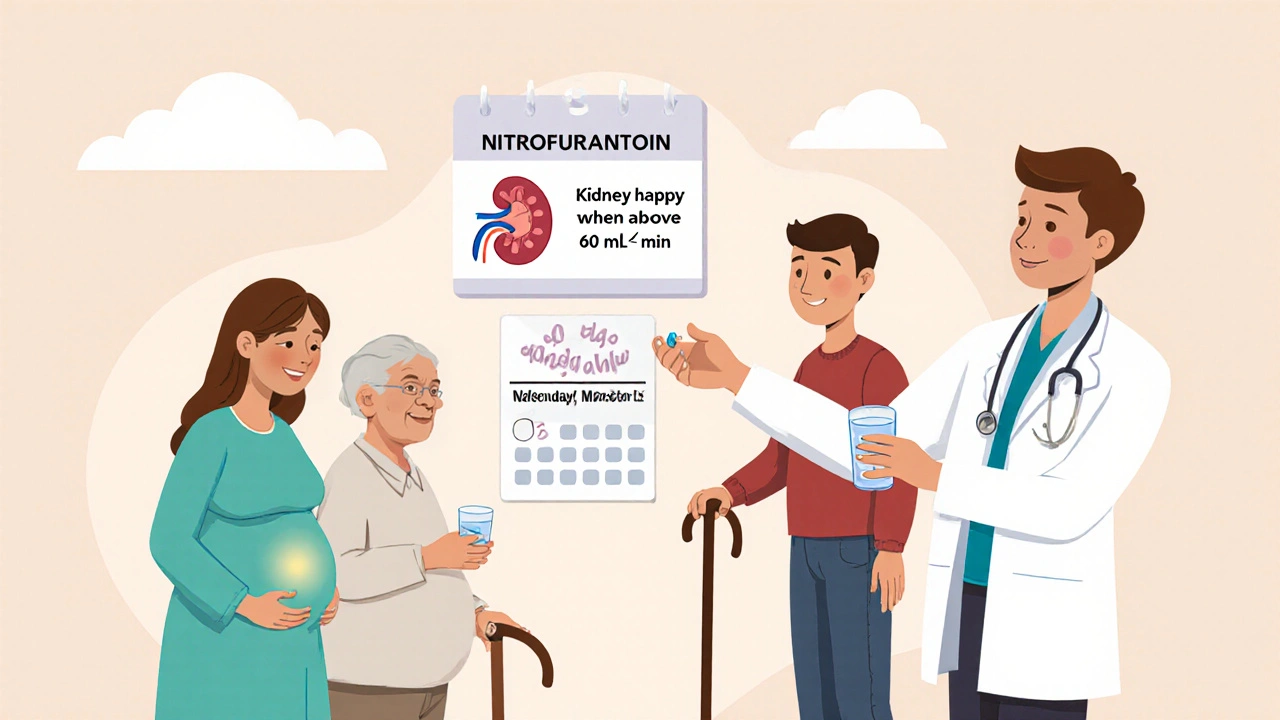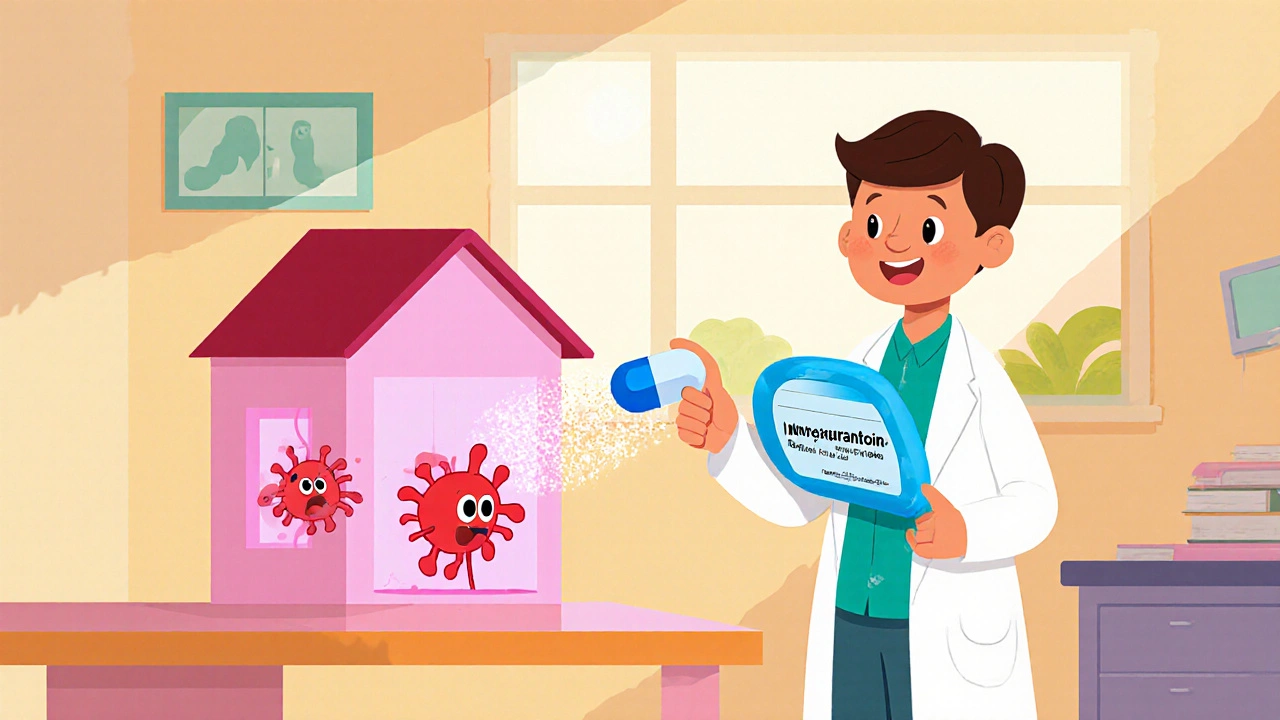Nitrofurantoin Suitability Calculator
Is Nitrofurantoin Right for Your Patient?
This tool helps determine if nitrofurantoin is appropriate for treating uncomplicated UTIs based on key clinical factors.
When a simple bladder infection strikes, many people reach for the first antibiotic that comes to mind. But not every pill works the same way, and some carry more risks than others. nitrofurantoin has been a go‑to drug for uncomplicated urinary tract infections (UTIs) for decades, yet its benefits are often overlooked in favor of newer, broader‑spectrum options. This article unpacks why nitrofurantoin remains a smart, targeted choice, what makes it work, and how to use it safely.
Quick Takeaways
- Targets the most common UTI culprit, E. coli, with minimal impact on gut flora.
- Low resistance rates in the United States (<5% in recent CDC data) make it reliable for first‑line therapy.
- Ideal for patients with normal kidney function (creatinine clearance >60mL/min) and for most pregnant women after the first trimester.
- Short treatment courses (5‑7days) reduce side‑effect risk while maintaining cure rates above 90%.
- Well‑studied safety profile, but avoid in severe renal impairment or late‑stage pregnancy.
How Nitrofurantoin Works
Nitrofurantoin is a synthetic nitrofuran antibiotic that concentrates in the urine after oral ingestion. Once in the bladder, it interferes with bacterial enzymes involved in carbohydrate metabolism, leading to bacterial death. Because the drug is excreted almost unchanged, it hits the infection where it matters most without flooding the bloodstream.
This urinary‑focused action means nitrofurantoin is bactericidal against E. coli, the pathogen responsible for roughly 70-80% of uncomplicated UTIs. Its limited systemic exposure also helps preserve the normal gut microbiome, reducing the chance of secondary infections like Clostridioides difficile.
When Nitrofurantoin Is Recommended
Clinical guidelines from the FDA and the Infectious Diseases Society of America (IDSA) list nitrofurantoin as a first‑line treatment for uncomplicated cystitis in adults. The drug shines in these scenarios:
- Uncomplicated bladder infection without signs of kidney involvement.
- Patients with a recent urine culture showing E. coli sensitivity.
- Individuals seeking an antibiotic with a low impact on gut flora.
- Pregnant women after the first trimester, when the drug’s safety data is strongest.
It is not suitable for pyelonephritis (kidney infection) or for patients whose kidney function is severely reduced (creatinine clearance < 60mL/min), because the drug will not achieve therapeutic urine concentrations.
Benefits Over Other Common UTIs Antibiotics
Many prescribers reach for trimethoprim‑sulfamethoxazole (TMP‑SMX) or fluoroquinolones simply because they’re familiar. Nitrofurantoin offers several distinct advantages:
- Lower resistance rates: CDC surveillance shows resistance to TMP‑SMX climbing above 20% in many regions, while nitrofurantoin resistance stays under 5%.
- Reduced collateral damage: By staying in the urinary tract, nitrofurantoin spares the gut microbiome, lowering risks of yeast infections and C.difficile.
- Shorter courses: A 5‑day regimen is usually enough, compared with 7‑10 days for TMP‑SMX.
- Fewer drug‑drug interactions: Nitrofurantoin does not significantly affect cytochrome P450 enzymes, making it safer with many chronic medications.

Dosage, Administration, and What to Expect
The standard adult dose is 100mg twice daily with food to improve absorption and reduce stomach upset. For children (age>1year) the dose is weight‑based (5‑7mg/kg) twice daily.
Key administration tips:
- Take the pill with a full glass of water.
- Never skip meals when taking nitrofurantoin; food enhances bioavailability.
- Complete the entire prescription, even if symptoms improve after a couple of days.
Typical side effects include mild nausea, headache, or a metallic taste. Most resolve within a few days, especially if the drug is taken with food.
Safety Profile and Common Concerns
While nitrofurantoin is generally well‑tolerated, certain safety issues deserve attention:
- Pulmonary toxicity: Rare but serious interstitial lung disease can develop after prolonged use (>6months). Short courses for UTIs are far less risky.
- Hepatotoxicity: Very uncommon; monitor liver enzymes if therapy exceeds 14days.
- Hemolysis in G6PD deficiency: Patients with this enzymatic disorder can experience hemolytic anemia. A quick screening test is advisable if the deficiency is suspected.
- Pregnancy considerations: FDA categorizes nitrofurantoin as a Pregnancy Category B drug for the first and second trimesters. In the third trimester, avoid use near delivery due to a potential risk of neonatal hemolysis.
Overall, the side effects rate is lower than many broad‑spectrum antibiotics, making it a patient‑friendly option.
Special Populations: Pregnancy, Elderly, and Renal Impairment
Pregnant women: Guidelines recommend nitrofurantoin for cystitis after the first trimester, provided there are no contraindications such as severe renal insufficiency. Its limited systemic exposure is reassuring for fetal safety.
Elderly patients: Age‑related decline in kidney function can limit nitrofurantoin use. Always verify creatinine clearance before prescribing; if it falls below 60mL/min, consider alternatives like fosfomycin.
Renal impairment: Because the drug needs to be excreted into the urine, patients with reduced renal function may not achieve therapeutic levels, leading to treatment failure.

How Nitrofurantoin Stacks Up: A Quick Comparison
| Attribute | Nitrofurantoin | Trimethoprim‑SMX | Fosfomycin |
|---|---|---|---|
| Typical Dose | 100mg PO BID for 5‑7days | 160mg PO BID for 3days | 3g PO single dose |
| Key Spectrum | Primarily E. coli, some Enterococcus | Broad gram‑positive & gram‑negative | Broad, including multi‑drug‑resistant strains |
| Resistance Rate (US, 2023) | ≈4‑5% | ≈20‑25% | ≈5‑10% |
| Renal Considerations | Requires CrCl >60mL/min | Safe down to CrCl 30mL/min | Effective even with reduced CrCl |
| Pregnancy Safety | Category B (1‑2 trimesters); avoid late 3rd trimester | Generally safe but watch sulfa allergy | Category B, single‑dose convenience |
| Impact on Gut Flora | Low | Moderate‑high | Low |
Practical Tips to Maximize Success
- Confirm the patient’s recent urine culture before choosing nitrofurantoin.
- Check renal function via eGFR or creatinine clearance.
- Advise patients to stay well‑hydrated; increased urine flow helps drug delivery.
- If nausea occurs, suggest taking the dose with a small snack or switching to the macrocrystalline formulation, which is gentler on the stomach.
- Schedule a follow‑up urine test only if symptoms persist beyond 48hours or recur within a month.
Frequently Asked Questions
Can I use nitrofurantoin for kidney infections?
No. Nitrofurantoin does not achieve high enough concentrations in the renal tissue to treat pyelonephritis. For kidney infections, doctors typically prescribe fluoroquinolones or extended‑spectrum β‑lactams.
Is nitrofurantoin safe for men?
Yes, it works for men with uncomplicated bladder infections. However, men are more likely to have prostatitis, which nitrofurantoin cannot adequately treat because it does not penetrate prostatic tissue well.
What should I do if I develop a rash while taking nitrofurantoin?
Stop the medication and contact your healthcare provider immediately. A rash can signal an allergic reaction or, rarely, the early stages of pulmonary toxicity.
Can nitrofurantoin be taken with antacids?
Antacids containing magnesium or aluminum can reduce nitrofurantoin absorption. Space the doses at least two hours apart.
Why is nitrofurantoin not recommended in late pregnancy?
Near term, the drug can cross the placenta and cause hemolytic anemia in the newborn, especially if the baby has G6PD deficiency. Alternate antibiotics are preferred for delivery‑related infections.
Bottom Line
If you need an effective, targeted, and relatively low‑risk option for uncomplicated bladder infections, nitrofurantoin should be at the top of your list. Its focused action against E. coli, low resistance rates, and minimal gut‑flora disruption make it a win‑win for patients and clinicians alike. Just remember to verify kidney function, avoid use in severe renal impairment, and follow the short‑course guidelines for the best outcomes.

Patrick Hendrick
October 15, 2025 AT 18:42Great point! Nitrofurantoin really shines for uncomplicated UTIs, especially with its low resistance rates, short course, and minimal gut impact.
abhishek agarwal
October 18, 2025 AT 02:15Absolutely, the drug’s targeted action cuts down collateral damage, and that’s a win for patients-let’s keep pushing this as first‑line therapy.
Michael J Ryan
October 20, 2025 AT 09:49I’ve been prescribing nitrofurantoin for years and the outcomes keep impressing me. Patients love the short 5‑day course because they can get back to their busy lives quickly. The drug’s focus on the urinary tract means the rest of the body stays largely untouched. That’s a huge plus for people who are on multiple meds and worry about drug interactions. In multicultural settings we see fewer side‑effects, which helps build trust across language barriers. Nitrofurantoin’s low resistance numbers make it a reliable choice even when labs are delayed. By sparing the gut flora, we reduce the risk of nasty C. difficile infections that can derail treatment. I always remind patients to take it with food and a full glass of water to ease any stomach upset. For pregnant women after the first trimester, it’s one of the safest options out there. The guidelines from IDSA and FDA line up nicely, reinforcing its first‑line status. When you check creatinine clearance above 60 mL/min, the drug reaches therapeutic levels in the urine. That renal check is a quick lab test that saves a lot of guesswork. Even men with uncomplicated cystitis benefit, though we have to watch for prostatitis, which nitrofurantoin can’t penetrate well. If nausea crops up, switching to the macrocrystalline formulation often makes a big difference. Overall, the balance of efficacy, safety, and simplicity keeps nitrofurantoin at the top of my recommendation list.
Khalil BB
October 22, 2025 AT 17:22Nitrofurantoin proves that precision beats brute force every time.
Keri Shrable
October 25, 2025 AT 00:55Nitrofurantoin is like the quiet hero of UTIs-low‑key but packs a punch for that pesky E. coli.
Destiny Hixon
October 27, 2025 AT 07:29Look folks this American‑made antibiotic kicks butt on UTIs and we shouldn’t let foreign meds stole the spotlight.
mike brown
October 29, 2025 AT 15:02Sure.
shawn micheal
October 31, 2025 AT 22:35I totally get the frustration when side‑effects pop up, but remember that most issues are mild and pass quickly when you stick to food‑timed dosing. Staying hydrated also helps the drug flush out the bacteria faster, and if nausea lingers, the macrocrystalline version is gentler. Keep an open line with your doc, and they’ll adjust the regimen if needed. You’ve got this, and the short course means you’ll be back to feeling normal before you know it.
Stephen Jahl
November 3, 2025 AT 06:09From a pharmcokinetic standpoint, nitrofurantoin’s preferential renal excretion, coupled with its bactericidal mechanism targeting bacterial carbohydrate metabolism, renders it a quintessential narrow‑spectrum agent; however, clinicians must vigilantly monitor for idiosyncratic pulmonary toxicity, albeit rare, as well as potential hemolytic events in G6PD‑deficient cohorst. The therapeutic index remains favorable, yet the ontological burden of adverse effect surveillance should not be dismissed.
gershwin mkhatshwa
November 5, 2025 AT 13:42Just a heads‑up: if you’re on antacids, space them out by a couple of hours so nitrofurantoin absorbs properly.
Louis Robert
November 7, 2025 AT 21:15Good reminder-always check kidney function before prescribing.
tim jeurissen
November 10, 2025 AT 04:49It is imperative to underscore that the clinical efficacy of nitrofurantoin is predicated upon an adequate creatinine clearance threshold, typically exceeding 60 mL/min; failure to adhere to this parameter may culminate in subtherapeutic urinary concentrations and consequent treatment failure.
lorna Rickwood
November 12, 2025 AT 12:22nitrofurantoin shows us that sometimes the smallest dose can carry the biggest impact the body’s own rivers guide the medicine home
S. Davidson
November 14, 2025 AT 19:55While the article mentions low resistance, it neglects to address regional variations where resistance can climb up to 15 %, especially in areas with overprescription of fluoroquinolones.
Haley Porter
November 17, 2025 AT 03:29The therapeutic landscape of uncomplicated cystitis is a microcosm of antimicrobial stewardship, where the principle of “use narrow‑spectrum first” resonates with both ecological and clinical imperatives. Nitrofurantoin, by virtue of its urinary concentration and limited systemic exposure, exemplifies this principle. Its pharmacodynamic profile aligns with the post‑antibiotic effect necessary to eradicate E. coli without fostering collateral flora disruption. Moreover, the drug’s safety data, accrued over decades, provide a robust evidentiary base for continued first‑line endorsement. Yet, clinicians must remain vigilant of patient‑specific factors such as renal clearance, pregnancy trimester, and potential G6PD deficiency. In doing so, they honor the balance between efficacy and safety, a tenet central to modern medicine. The interplay of microbiology, pharmacology, and patient demographics creates a dynamic decision matrix that nitrofurantoin navigates adeptly. Ultimately, its judicious use underscores a broader commitment to preserving antimicrobial efficacy for future generations.
Sharath Babu Srinivas
November 19, 2025 AT 11:02Excellent summary! 🌟 Remember to double‑check dosage instructions and reinforce the importance of completing the full course. 👍
zaza oglu
November 21, 2025 AT 18:35Let’s keep sharing these evidence‑based tips so everyone can feel confident about their UTI treatment options.